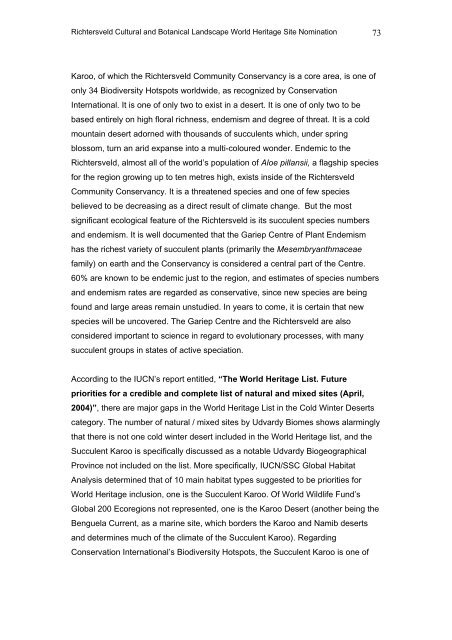the richtersveld cultural and botanical landscape - SAHRA
the richtersveld cultural and botanical landscape - SAHRA
the richtersveld cultural and botanical landscape - SAHRA
You also want an ePaper? Increase the reach of your titles
YUMPU automatically turns print PDFs into web optimized ePapers that Google loves.
Richtersveld Cultural <strong>and</strong> Botanical L<strong>and</strong>scape World Heritage Site Nomination 73<br />
Karoo, of which <strong>the</strong> Richtersveld Community Conservancy is a core area, is one of<br />
only 34 Biodiversity Hotspots worldwide, as recognized by Conservation<br />
International. It is one of only two to exist in a desert. It is one of only two to be<br />
based entirely on high floral richness, endemism <strong>and</strong> degree of threat. It is a cold<br />
mountain desert adorned with thous<strong>and</strong>s of succulents which, under spring<br />
blossom, turn an arid expanse into a multi-coloured wonder. Endemic to <strong>the</strong><br />
Richtersveld, almost all of <strong>the</strong> world’s population of Aloe pillansii, a flagship species<br />
for <strong>the</strong> region growing up to ten metres high, exists inside of <strong>the</strong> Richtersveld<br />
Community Conservancy. It is a threatened species <strong>and</strong> one of few species<br />
believed to be decreasing as a direct result of climate change. But <strong>the</strong> most<br />
significant ecological feature of <strong>the</strong> Richtersveld is its succulent species numbers<br />
<strong>and</strong> endemism. It is well documented that <strong>the</strong> Gariep Centre of Plant Endemism<br />
has <strong>the</strong> richest variety of succulent plants (primarily <strong>the</strong> Mesembryanthmaceae<br />
family) on earth <strong>and</strong> <strong>the</strong> Conservancy is considered a central part of <strong>the</strong> Centre.<br />
60% are known to be endemic just to <strong>the</strong> region, <strong>and</strong> estimates of species numbers<br />
<strong>and</strong> endemism rates are regarded as conservative, since new species are being<br />
found <strong>and</strong> large areas remain unstudied. In years to come, it is certain that new<br />
species will be uncovered. The Gariep Centre <strong>and</strong> <strong>the</strong> Richtersveld are also<br />
considered important to science in regard to evolutionary processes, with many<br />
succulent groups in states of active speciation.<br />
According to <strong>the</strong> IUCN’s report entitled, “The World Heritage List. Future<br />
priorities for a credible <strong>and</strong> complete list of natural <strong>and</strong> mixed sites (April,<br />
2004)”, <strong>the</strong>re are major gaps in <strong>the</strong> World Heritage List in <strong>the</strong> Cold Winter Deserts<br />
category. The number of natural / mixed sites by Udvardy Biomes shows alarmingly<br />
that <strong>the</strong>re is not one cold winter desert included in <strong>the</strong> World Heritage list, <strong>and</strong> <strong>the</strong><br />
Succulent Karoo is specifically discussed as a notable Udvardy Biogeographical<br />
Province not included on <strong>the</strong> list. More specifically, IUCN/SSC Global Habitat<br />
Analysis determined that of 10 main habitat types suggested to be priorities for<br />
World Heritage inclusion, one is <strong>the</strong> Succulent Karoo. Of World Wildlife Fund’s<br />
Global 200 Ecoregions not represented, one is <strong>the</strong> Karoo Desert (ano<strong>the</strong>r being <strong>the</strong><br />
Benguela Current, as a marine site, which borders <strong>the</strong> Karoo <strong>and</strong> Namib deserts<br />
<strong>and</strong> determines much of <strong>the</strong> climate of <strong>the</strong> Succulent Karoo). Regarding<br />
Conservation International’s Biodiversity Hotspots, <strong>the</strong> Succulent Karoo is one of

















